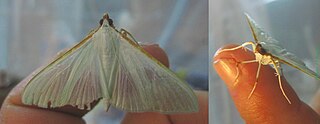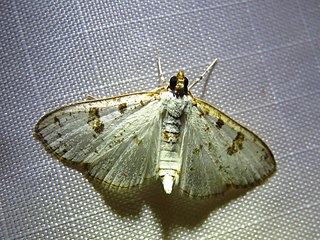
Palpita vitrealis, common name jasmine moth or white pearl, is a species of moth of the family Crambidae.

Pycnarmon is a genus of moths of the family Crambidae described by Julius Lederer in 1863.

Palpita is a genus of moths of the family Crambidae. Members of the moth genus Stemorrhages may be very similar in appearance.

Patania is a genus of moths of the family Crambidae described by Frederic Moore in 1888.

Stemorrhages is a genus of moths of the family Crambidae described by Julius Lederer in 1863. Members of the moth genus Palpita may be very similar.

Macrochilo orciferalis, the chocolate fan-foot or bronzy macrochilo, is a litter moth of the family Erebidae. The species was first described by Francis Walker in 1859. It is found in North America from Wisconsin to Nova Scotia, south to Florida and Texas.

Diaphania indica, the cucumber moth or cotton caterpillar, is a widespread but mainly Old World moth species. It belongs to the grass moth family, and therein to the large subfamily Spilomelinae. This moth occurs in many tropical and subtropical regions outside the Americas, though it is native to southern Asia; it is occasionally a significant pest of cucurbits and some other plants.

Poliobotys is a monotypic moth genus of the family Crambidae described by Jay C. Shaffer and Eugene G. Munroe in 2007. Its single species, Poliobotys ablactalis, was described by Francis Walker in 1859. It occurs throughout South-east Asia, including Réunion, Australia, Hong Kong and Africa.

Banisia myrsusalis, the sapodilla borer or sapota midrib folder, is a species of moth of the family Thyrididae. It was described by Francis Walker in 1859 and is found in North America, Brazil, Australia, southern Asia and Africa.
Palpita elealis is a moth in the family Crambidae. It was described by Francis Walker in 1859. It is found in Cameroon, the Republic of the Congo, the Democratic Republic of the Congo, Ghana, Ivory Coast, Sierra Leone, South Africa, São Tomé and Príncipe, the Gambia, Zambia and Zimbabwe.
Palpita kimballi, or Kimball's palpita moth, is a moth in the family Crambidae. It was described by Eugene G. Munroe in 1959. It is found in North America, where it has been recorded from Alabama, Florida, Georgia, Louisiana, North Carolina, Oklahoma, South Carolina, Tennessee and Virginia.
Palpita claralis is a moth in the family Crambidae. It was described by Francis Walker in 1866. It is found in South Africa and Malawi.
Palpita eribotalis is a moth in the family Crambidae. It was described by Francis Walker in 1859. It is found in Honduras.
Palpita jairusalis is a moth in the family Crambidae. It was described by Francis Walker in 1859. It is found in Venezuela.

Palpita illibalis, the inkblot palpita moth, is a moth in the family Crambidae. It was described by Jacob Hübner in 1818. It is found in North America, where it has been recorded from Alabama, Florida, Georgia, Maryland, Mississippi, North Carolina, Ohio, Oklahoma, Pennsylvania, South Carolina, Tennessee, Virginia and West Virginia.

Margaroniini is a tribe of the species-rich subfamily Spilomelinae in the pyraloid moth family Crambidae. The tribe was erected by Charles Swinhoe and Everard Charles Cotes in 1889, originally as family Margaronidae.
This page is based on this
Wikipedia article Text is available under the
CC BY-SA 4.0 license; additional terms may apply.
Images, videos and audio are available under their respective licenses.










